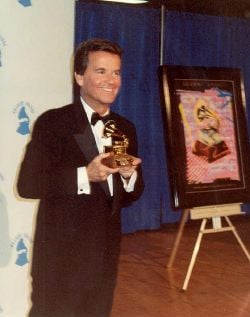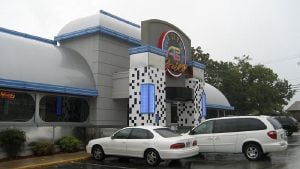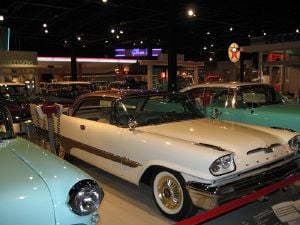Dick Clark
| Dick Clark | |
 Dick Clark backstage during the Grammy Awards telecast in 1990
| |
| Born | Richard Wagstaff Clark November 30 1929 (age 94) Mount Vernon, New York, USA |
|---|---|
| Died | April 18 2012 (aged 82) Santa Monica, California, U.S. |
| Other names | The World's Oldest Teenager (nickname) |
| Children | Richard Augustus "Rac" Clark II (b. 1957; mother Barbara) Duane Clark and Cindy Clark (b. January 8, 1965) (mother Loretta) |
Richard Wagstaff "Dick" Clark (November 30, 1929 - April 18, 2012) was an American television, radio personality, game show host, and businessman. He is best known for hosting long-running television shows such as American Bandstand, the Pyramid game show, and Dick Clark's New Year's Rockin' Eve. He also served as chairman and CEO of Dick Clark Productions.
Clark was long known for his his youthful appearance, earning the moniker "America's Oldest Teenager." He established this image hosting American Bandstand, which first aired nationally on August 5, 1957. Shown weekday afternoons on Philadelphia channel WFIL and broadcast nationwide, the program featured area teenagers voicing their opinions on the latest songs and dancing the most popular steps, such as The Slop, The Hand Jive, and The Bop. Featured guest artists on the show included many of rock and roll's top stars: Elvis Presley, Buddy Holly, Chuck Berry, Fats Domino, Stevie Wonder, Jerry Lee Lewis, Frankie Avalon, James Brown, The Coasters, Sam Cooke, The Shirelles, Dusty Springfield, and the Beach Boys.
After American Bandstand, Clark had a long career as a game show and entertainment executive. In 1993, Clark was inducted into both the Rock and Roll Hall of Fame and the Academy of Television Arts & Sciences Hall of Fame. He suffered a stroke late in 2004. With some speech ability still impaired, Clark returned to his New Year's Rockin' Eve show on December 31, 2005. Subsequently, he appeared at the Emmy Awards on August 27, 2006, and every New Year's Rockin' Eve show through the 2011–2012 show. Clark died on April 18, 2012 of a heart attack at age 82.
Life and career
Personal life and early career
Dick Clark was born in Mount Vernon, New York, where he was raised, the son of Julia Fuller (née Barnard) and Richard Augustus Clark. His only sibling, older brother Bradley, was killed in World War II. Clark has been married three times. His first marriage was to Barbara Mallery in 1952; the couple had one son, Richard A. (named after his father), and divorced in 1961. Clark married Loretta Martin in 1962; they had two children, Duane and Cindy, and divorced in 1971. Clark has been married to his current wife, Kari Wigton, since 1977.
Clark's career in show business began in 1945, when he started working in the mailroom of radio station WRUN in Utica, New York, which was owned by his uncle and managed by his father. He was soon promoted to weatherman and news announcer. Clark attended Syracuse University and was a member of Delta Kappa Epsilon fraternity. He graduated from Syracuse in 1951, and began his television career at station WKTV in Utica, and was also subsequently a DJ on 1490 WOLF (AM) Syracuse. Clark's first television hosting job was on the Cactus Dick and the Santa Fe Riders, a country music program. He would later replace Robert Earle (who would later host the GE College Bowl) as a newscaster.
American Bandstand
In 1952, Clark moved to Philadelphia and took a job as a disc jockey at radio station WFIL. WFIL had an affiliated television station that began broadcasting a show called Bob Horn's Bandstand in 1952. Clark was a regular substitute host on the show, and when Horn left, Clark became the full-time host on July 9, 1956. The show was picked up by ABC and was first aired nationally on August 5, 1957, and renamed American Bandstand. A high point on the show was Clark's interview with Elvis Presley on January 8, 1960.
WFIL's Studio B, where the program was filmed, measured 80 by 42 by 24 feet, but appeared smaller due to the number of props, television cameras, and bleachers that were used for the show. The show was briefly shot in color in 1958 when WFIL-TV started experimenting with the then-new technology.
Bandstand aired every weekday afternoon for its first six years. Clark would frequently interview the teenagers about their opinions of the songs being played, most memorably through the "Rate-a-Record" segment; the frequent response being: "It's got a good beat and you can dance to it." Dancing was a major component of Bandstand. The kids who showed up every day—the "regulars"—knew all the most popular steps, such as The Slop, The Hand Jive, and The Bop. They even improvised some, including, The Stroll, The Circle, and The Chalypso. When Chubby Checker introduced The Twist to the Bandstand crowd—and through it to the nation—the dance became an overnight sensation.
Many American teens from all over the nation spent their weekday afternoons in front of the television with the "American Bandstand" kids in Philly. Among the many artists who appeared on the show in its heydey, were: Buddy Holly and the Crickets, Chuck Berry, LaVerne Baker, Little Stevie Wonder, Frankie Avalon, Annette Funicello, James Brown, The Coasters, Sam Cooke, The Shirelles, Dusty Springfield, Bobby Rydell, Paul Anka, Fontella Bass, Isaac Hayes, Roy Orbison, Fabian, Paul Anka, Bobby Darin, the Crystals, the Drifters, and the Beach Boys.
Clark also began investing in the music publishing and recording business in the 1950s. In 1959, the United States Senate opened investigations into "payola," the practice of music-producing companies paying broadcasting companies to favor their product. Clark, as a major figure in both fields, was investigated and testified before Congress in 1960. He was not charged with any illegal activities, but he was required by ABC to divest his publishing and recording interests.
Unaffected by the investigation, American Bandstand was a major success, running daily until 1963, then weekly until 1987. In 1964, the show moved from Philadelphia to Hollywood. A spin-off of the show, Where the Action Is, aired from 1965 to 1967, also on ABC. Charlie O'Donnell, a close friend of Clark's and an up-and-coming fellow Philadelphia disc-jockey, was chosen to be the announcer, where he served for 10 years. O'Donnell was one of the announcers on the 1980s versions of Clark's Pyramid game show. To this day, he continues to work with Clark on various specials and award shows.
Clark produced Bandstand for syndication and later the USA cable network until 1989, again hosting in 1987 and 1988 before giving up the emcee reins to David Hirsch in its final year.
Dick Clark's New Year's Rockin' Eve
In 1972, Clark produced and hosted Dick Clark's New Year's Rockin' Eve, the first of an ongoing series of specials still broadcast on New Year's Eve. The program typically consisted of live remotes of Dick Clark in Times Square in New York City, counting down until the New Year ball comes down. After the ball drops, the focus of the program switches to musical segments taped prior to the show in Hollywood.
Clark suffered a stroke late in 2004 and was unable to host the 2004-2005 show. With some speech ability still impaired, Clark returned to the show on December 31, 2005. From 2005 to 2012, Clark co-hosted New Year's Rockin Eve with Ryan Seacrest, with the program renamed to reflect both hosts for its 2008-2009 edition. In the four decades it has been on the air, the show has become a mainstay in U.S. New Year's Eve celebrations. Watching the ball in Times Square drop on Clark's show was considered an annual cultural tradition for the New Year's holiday for the last decades of his life.
Pyramid game shows
Before Pyramid, Clark had two brief runs as a quiz-show host, presiding over The Object Is and then Missing Links. In a near twist of irony, on Missing Links he replaced his former Philadelphia neighbor and subsequent TV's Bloopers & Practical Jokes co-host, Ed McMahon, when the game show switched networks from NBC to ABC; NBC replaced Missing Links with Jeopardy!
Clark later became host of The $10,000 Pyramid, which premiered on CBS March 26, 1973. The show—a word association game created and produced by daytime TV legend Bob Stewart—moved to ABC from 1974 to 1980, during which time the top prize was upgraded to $20,000. After a brief 1981 syndicated run as The $50,000 Pyramid, the show returned to CBS in 1982 as The $25,000 Pyramid, and continued through 1988, except for a three-month break. From 1985 to 1988, Clark hosted both the CBS $25,000 version and a daily $100,000 Pyramid in syndication.
Clark's daytime versions of Pyramid won nine Emmy Awards for best game show, a mark that is eclipsed only by the 11 won by the syndicated version of Jeopardy! It also won Clark three Emmy Awards for best game show host.
Other radio programs
Clark also had a long stint as a top 40 radio countdown show host. He began in 1963, hosting a radio program called the Dick Clark Radio Show. It was produced by Mars Broadcasting Of Stanford, Connecticut. Despite his enormous popularity on American Bandstand, the show was only picked up by a few dozen stations and lasted less than a year.
Clark hosted one episode of American Top 40 in 1971 substituting for Casey Kasem. Several years later, he would become one of AT40's most enduring rivals. In 1981, he created The Dick Clark National Music Survey for the Mutual Broadcasting System, which counted down the Top 30 contemporary hits of the week, in direct competition with American Top 40. After he left Mutual in 1986, he turned over National Music Survey duties to Charlie Tuna and took over hosting duties of another show, Countdown America. By the 1990s, Clark hosted U.S. Music Survey, which he hosted up until his 2004 stroke.
Also beginning in 1982, Clark hosted a weekly weekend-radio program distributed by his own syndicator, The United Stations Radio Networks. The program was an oldies program entitled Dick Clark's Rock, Roll, and Remember (named after his 1976 autobiography). After his 2004 stroke, United Stations began re-issuing old episodes of Rock, Roll, and Remember to affiliates, and re-runs of the program still air today.
Other television programs
Clark has been involved in a number of other television series and specials as producer and performer. One of his most well-known guest appearances was in the final episode of the original Perry Mason TV series ("The Case of the Final Fadeout") in which he was revealed to be the killer in a dramatic courtroom scene.
In 1973, Clark created the American Music Awards show, which he produces annually. Intended as competition for the Grammy Awards, in some years it gained a bigger audience than the Grammys due to being more in touch with popular trends.
In 1984, Clark produced and co-hosted (with Ed McMahon) the NBC series, TV's Bloopers & Practical Jokes. The series ran through 1988 and continued in specials hosted by Clark (sometimes joined by another TV personality) into the twenty first century, first on NBC, later on ABC. The "Bloopers" franchise stems from the Clark-hosted (and produced) NBC "Bloopers" specials of the early 1980s, inspired by the books, record albums, and appearances of Kermit Schafer, a radio and TV producer who first popularized outtakes of broadcasts.
For a period of several years in the 1980s, Clark simultaneously hosted regular programs on the three major American television networks: ABC (Bandstand), CBS (Pyramid), and NBC (Bloopers) and in 1993, he hosted Scattergories.
In 1990 and 1991, Clark hosted the syndicated TV game show The Challengers, which only lasted for one season. In 1999, he was one of the executive producers of Fox Network's TV game show Greed, which ran from November 5, 1999 to July 14, 2000, and was hosted by Chuck Woolery. At the same time, Clark also hosted the Stone-Stanley-created Winning Lines, which ran for six weeks on CBS from January 8-February 12, 2000.
From 2001 to 2003, Clark was a co-host of The Other Half, a syndicated daytime talk show intended to be the male equivalent of The View. Clark also produced the television series American Dreams about a Philadelphia family in the early 1960s whose daughter is a regular on American Bandstand. The series ran from 2002 to 2005.
Entertainment ventures
Clark has a stake in a chain of music-themed restaurants licensed under the names "Dick Clark's American Bandstand Grill," "Dick Clark's AB Grill," "Dick Clark's Bandstand—Food, Spirits & Fun," and "Dick Clark's AB Diner." His Dick Clark's American Bandstand Theater opened in Branson, Missouri in April 2006. A theater and restaurant called "Dick Clark's American Bandstand Music Complex" opened in Pigeon Forge, Tennessee in June 2007.
In the basement of the "Dick Clark's American Bandstand Theater" in Branson, Missouri is '57 Heaven, which boasts "…the world's largest collection of 1957 automobiles and memorabilia showcased in Hometown America." The exhibit also recreates a drive-in movie, gas station, barbershop, car dealership, service station, motel, and a typical 1950s home.
Stroke and last years
In 2004, it was revealed that Clark had Type 2 diabetes, and on December 8, 2004, Clark was hospitalized in Los Angeles after suffering what was initially termed a minor stroke. However, on December 13, 2004, it was announced that Clark would be unable to host his annual New Year's Rockin' Eve broadcast, that had aired for all but one year since 1972. For the 2004 show, Regis Philbin was the substitute host.
While having not been seen in public anywhere since his stroke, on August 15, 2005, Clark announced in a statement that he would be back in Times Square for the annual tradition, bringing on Hilary Duff and Ryan Seacrest as co-hosts.
On December 31, 2005, Clark made his return to television, returning to the Dick Clark's New Year's Rockin' Eve broadcast, having noticeable difficulty speaking, slightly slurring his famous countdown to the new year. During the program, Clark remained behind a desk, and was shown only in limited segments. On-air, Clark said, "Last year I had a stroke. It left me in bad shape. I had to teach myself how to walk and talk again. It's been a long, hard fight. My speech is not perfect, but I'm getting there." Clark also appeared on the 2006 Emmy Award telecast on August 27, 2006. The show paid tribute to his successful career that has spanned decades.
For the ABC New Year's Eve 2007-2008 appearance, Clark still exhibited noticeably slurred and somewhat breathless speech, but improved from previous years, in addition to using his arms again.
On April 18, 2012, Clark died of a heart attack following surgery on an enlarged prostate at Saint John's Health Center and the Pacific Urology Institute in Santa Monica, California. Clark was cremated on April 20, and his ashes were scattered in the Pacific Ocean.
Legacy
Dick Clark was a major force in the music and television industry for over 40 years. He became an American icon on American Bandstand, which became an integral part of the early rock and roll culture and from which he created an entertainment empire that by 1985 had 170 television programming hours a week. Known as America's "oldest teenager," Clark, the enthusiastic television host and radio announcer, is credited with bringing to light some of rock and roll's brightest stars. As an exceptional businessman, Dick Clark Productions produced a plethora of made-for-TV movies, game shows, award shows, beauty pageants, and "reality" programs.
Awards, recognition
- Emmy Awards (1979, 1983, 1985, and 1986)
- Daytime Emmy Lifetime Achievement Award (1994)
- Peabody Award (1999)
- Hollywood Walk of Fame (1976)
- Radio Hall of Fame (1990)
- Broadcasting Magazine Hall of Fame (1992)
- Rock and Roll Hall of Fame (1993)
- Academy of Television Arts & Sciences Hall of Fame (1993)
ReferencesISBN links support NWE through referral fees
- Clark, Dick, and Fred Bronson. Dick Clark's American Bandstand. New York, NY: Collins Publishers, 1997. ISBN 978-0006491842.
- Jackson, John A. American Bandstand: Dick Clark and the Making of a Rock 'n' Roll Empire. New York: Oxford University Press, 1997. ISBN 978-0195093230.
- Uslan, Michael, Dick Clark, and Bruce Solomon. Dick Clark's the First 25 Years of Rock & Roll. New York, NY: Dell Pub. Co., 1981. ISBN 978-0440517634.
External links
All links retrieved January 29, 2024.
- Dick Clark at the Internet Movie Database
- Today in American Bandstand/Dick Clark History
Credits
New World Encyclopedia writers and editors rewrote and completed the Wikipedia article in accordance with New World Encyclopedia standards. This article abides by terms of the Creative Commons CC-by-sa 3.0 License (CC-by-sa), which may be used and disseminated with proper attribution. Credit is due under the terms of this license that can reference both the New World Encyclopedia contributors and the selfless volunteer contributors of the Wikimedia Foundation. To cite this article click here for a list of acceptable citing formats.The history of earlier contributions by wikipedians is accessible to researchers here:
The history of this article since it was imported to New World Encyclopedia:
Note: Some restrictions may apply to use of individual images which are separately licensed.

